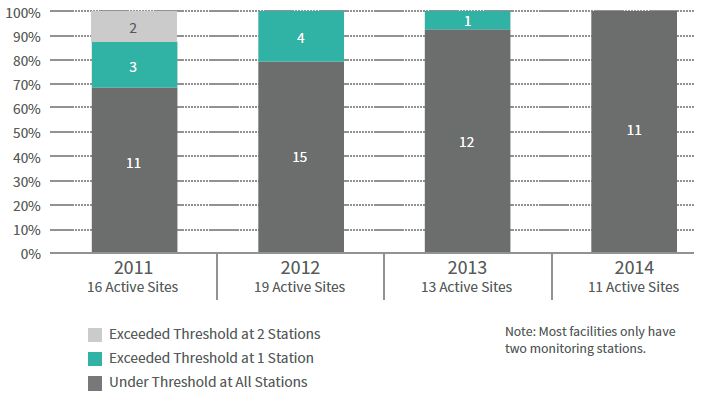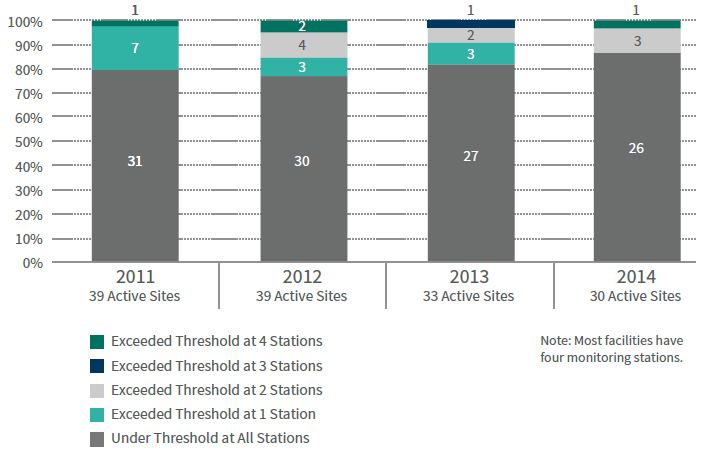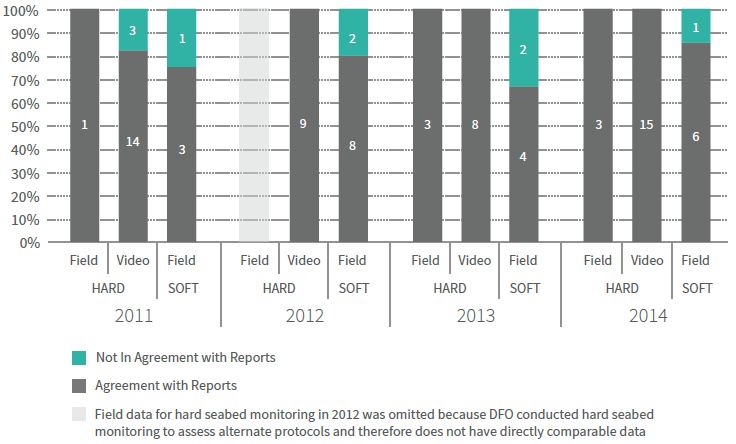Regulating and monitoring British Columbia’s marine finfish aquaculture facilities 2011–2014
Table of Contents
- Summary of marine finfish aquaculture in British Columbia
- How aquaculture facilities are regulated
- Assessing compliance
- Reporting requirements and reports submitted
- Monitoring and audits: Fish health
- Monitoring and audits: Environmental
- Monitoring and audits: Inventory and aquaculture statistics
- Summary
Monitoring and audits: Environmental
Benthic (Seabed) Monitoring
The aquaculture industry is required by their licence conditions to conduct benthic monitoring at all of their sites. This ensures that the impacts of organic waste (mainly fish feces) from the sites are restricted in extent and intensity. As part of its monitoring program, DFO staff conduct benthic audits as well as information-gathering surveys. During the audits, DFO follows the same procedures as industry, samples within the same time frame (within 30 days before or after the peak biomass date), and samples similar locations, all of which allows DFO results to be directly compared with industry results.
At sites with a hard ocean substrate (seabed), video data is gathered using remotely operated vehicles (ROVs) with underwater cameras. At least two transects (lines along the seabed) are monitored at each site. Video is taken from the cage edge to at least 140 metres away on at least two sides of the fish farm site. More sampling may be required as outlined in the licence or as prescribed by DFO.
The video collected is assessed by industry representatives and DFO staff, who observe and record various types of information. The zone of compliance for hard bottom sites is between 100 and 124 metres from the cage array, although video is always also taken closer and farther away. The zone of compliance is divided into six segments, each 4 metres long, and each of the segments is assessed. If required, the post-compliance zone (124–140 metres away from the cage array) is also assessed.
To check whether hard-bottom sites comply with the licence conditions, DFO staff check the video footage to assess the area of the seabed covered by two indicators of organic waste: Beggiatoalike species, which are bacteria that form mats in areas of organic enrichment, and opportunistic polychaete complexes (OPCs), which are worms found in the seabed and in areas of organic enrichment. Although these species actually help break down accumulated waste, their abundance indicates impact due to organic enrichment.
When allowable thresholds of Beggiatoa-like species or OPCs are exceeded, the site must be fallowed (left empty) until further monitoring shows that it has recovered sufficiently.
Figure 14 summarizes the seabed sampling reports for facilities over hard or mixed seabed submitted by industry between 2011 and 2014. Industry-submitted data showed that for facilities over a hard seabed, an average of 80% of active facilities were under the allowable threshold at all monitoring stations.

Figure 14. Industry-Reported Seabed Monitoring at Peak Biomass for Facilities over Hard or Mixed Seabed - Table version
| 2011 | 2012 | 2013 | 2014 | |
| Exceeding threshold at 2 stations | 2 | 0 | 0 | 0 |
| Exceeding threshold at 1 stations | 3 | 4 | 1 | 0 |
| Under threshold at all stations | 11 | 15 | 12 | 11 |
| Total active sites | 16 | 19 | 13 | 11 |
At sites with a soft ocean substrate (seabed), at least two transects (lines across the seabed) are monitored by taking sediment samples at 0, 30, and 125 metres from the cage edge and analyzing the physical and chemical properties of the samples. Only data gathered from the 30 metre and 125 metre stations is used for regulatory purposes. Sediment sampling must occur at two sides of the cages and where the most impact is expected. More sampling may be required as outlined in the licence or as prescribed by DFO.
Compliance at soft seabed sites is determined by measuring the level of free sulphides. Free sulphides are related to the amount of oxygen in the sediment, which in turn contributes to the biodiversity (variety of living organisms) that the sediment can support. The standards for free sulphides are designed to manage the intensity of impact and ensure that the seabed can recover in a reasonable amount of time when fish are removed from marine net pens. When allowable amounts of free sulphides at the 30 metre and 125 metre stations are exceeded, the site must be fallowed (no fish) until further monitoring shows that it has recovered sufficiently.
Figure 15 summarizes the benthic sampling reports for facilities over soft or mixed seabed submitted by industry between 2011 and 2014. Industrysubmitted data showed that over 75% of active facilities were under the allowable threshold at all monitoring stations.

Figure 15. Industry-Reported Seabed Monitoring at Peak Biomass for Facilities over Soft or Mixed Seabed - Table version
| 2011 | 2012 | 2013 | 2014 | |
| Exceeding threshold at 4 stations | 1 | 2 | 0 | 1 |
| Exceeding threshold at 3 stations | 0 | 0 | 1 | 0 |
| Exceeding threshold at 2 stations | 0 | 4 | 2 | 3 |
| Exceeding threshold at 1 stations | 7 | 3 | 3 | 0 |
| Under threshold at all stations | 31 | 30 | 27 | 26 |
| Total active sites | 39 | 39 | 33 | 30 |
DFO’s Benthic Audit Program
DFO assesses industry’s benthic monitoring results by reviewing every incoming report and by conducting site audits. DFO site audits fulfill four purposes:
- To compare industry-generated data with DFO-generated data to ensure that industry is following the correct procedures and that the two data sets are similar.
- To determine whether the compliance sampling stations or transects used by industry are appropriate.
- To investigate sites with poor environmental performance.
- To learn more about benthic impacts during different parts of the production cycle and site recovery cycle.
For facilities with soft seabeds, DFO conducts field assessments in the same location as industry to compare the results. For facilities with hard seabeds, DFO reviews the video data captured by industry and/or conducts a field assessment at the same location as industry.
Figure 16 summarizes the field and video audits of industry-submitted reports between 2011 and 2014. Twenty-two sites were audited in 2011, 19 in 2012, 17 in 2013, 25 in 2014. In this four-year period, an average of 89% of DFO’s findings agreed with the industry-submitted reports.
Disagreement can arise in two ways: where industry found greater impact than DFO, and where industry found less impact than DFO. In the case of disagreement, DFO directs industry to use the monitoring results that show greater impact and to respond to the results as required by their licence.

Figure 16. DFO’s Assessment of Seabed Monitoring Reports from Industry - Table version
| 2011 | 2012 | 2013 | 2014 | |||||||||
| Hard | Soft | Hard | Soft | Hard | Soft | Hard | Soft | |||||
| Field | Video | Field | Field | Video | Field | Field | Video | Field | Field | Video | Field | |
| Not in agreement with reports | 0 | 3 | 1 | - | 0 | 2 | 0 | 0 | 2 | 0 | 0 | 1 |
| Agreement with reports | 1 | 14 | 3 | - | 9 | 8 | 3 | 8 | 4 | 3 | 15 | 6 |
| Field data for hard seabed monitoring in 2012 was omitted because DFO conducted hard seabed monitoring to assess alternate protocols and therefore does not have directly comparable data | ||||||||||||
Escapes
The aquaculture industry must take all reasonable measures to prevent the escape of cultivated fish, but in the unlikely event of an escape, the licence holder must take immediate action to control and confine it. Escapes are reported to DFO upon discovery, and a follow-up report is submitted within seven days after the escape or suspected escape. In 2011 and 2012, DFO required a monthly report of any fish that could not be accounted for based on inventory records (including nil reports). The requirement to report escapes monthly was discontinued in 2013. Since 2013, escape reports are only required when an incident occurs.
During site inspections, DFO staff visually review site integrity as well as records of cage maintenance and net integrity, ensuring that nets are of the appropriate strength and age, in good repair, inspected regularly, and deployed correctly.
Eight inspections were conducted in 2011, 14 in 2012, four in 2013 and four in 2014. All sites were found to be in compliance with the licence conditions.
To evaluate the risk associated with escaped Atlantic salmon, DFO staff periodically survey rivers to search for Atlantic salmon in B.C. waters. They focus on streams where Atlantic salmon are most likely to have established populations, based on sightings and captures reported to DFO. Extensive field work was conducted in 2011 and 2012 in 12 freshwater systems on Vancouver Island, and no Atlantic salmon at any life stage were identified.
Table 1 summarizes the total number of escaped fish reported by industry from 2011 to 2014. Detailed information on the escape of cultured fish, including the description of each incident, can be found at Escapes.
Incidental Catch
Wild fish sometimes swim into containment nets at marine finfish facilities and grow along with cultured fish until they are too large to swim out of the nets. Incidental catch are any wild fish caught or found dead within the facility during harvest, while fish are being moved within or between facilities, or during net removal. Aquaculture operations are not allowed to cultivate or sell any species of fish not listed on their licence. All incidental catch during transfer and harvest must be recorded and reported to DFO. The aquaculture industry must take reasonable care to reduce the risk of incidental catch and immediately return live incidental catch to waters outside the aquaculture facility in a manner that least harms the fish.
In 2011 and 2012, incidental catch was reported to DFO quarterly. In 2013 and 2014, reports were submitted within 14 calendar days of removing the nets after harvest. For facilities that continuously have fish present, records must be submitted every two years.
Table 2 summarizes the total number of incidental catch reported by industry from 2011 to 2014. For detailed information on incidental catch, including the number of fish and species killed, please visit: Reporting requirements and reports submitted: Incident reports.
DFO monitors fish harvests and transfers to ensure the proper handling, record-keeping, and identification of incidental catch. Field observations of harvest or transfer for the management of incidental catch began in 2013; no non-compliance has been found to date.
Interactions with Marine Mammals
Licence conditions require every aquaculture licence holder to take all reasonable measures to prevent marine mammals from coming into conflict with the facility infrastructure and farmed fish.
Industry must:
- have a Marine Mammal Conflict Mitigation Management Plan that DFO reviews for compliance with the licence
- report drownings and authorized predator control activities to DFO
DFO audits reports of marine mammal incidents to ensure that licence holders have taken reasonable preventative actions. If DFO has questions about the effectiveness of preventative actions, they follow up with the licence holder to review the details of the event.
Eight inspections were conducted in 2011; 14 in 2012; four in 2013; and four in 2014. Site inspections showed that marine mammal conflict management plans were being followed. DFO staff also review records on-site related to preventing escapes and managing marine mammal conflicts. For example, dive records indicate net maintenance and repairs (often required as a result of damage by marine mammals) as well as incidents in which marine mammals became entangled and were released.
Table 3 and Table 4 summarize the total number of marine mammals drowned and killed from 2011 to 2014. In 2011, following a high number of reported marine mammal shootings, DFO met with industry members to clarify the circumstances under which marine mammals can legally be dispatched. During all site visits, DFO communicates best practices for dealing with marine mammals.
Use of Lights
Underwater lighting at marine finfish aquaculture sites is used to delay the start of sexual maturation. This improves feeding behaviour, growth rates, and the quality of fish flesh. Lights are used within net cages at night from autumn to spring, when there are fewer hours of daylight.
Research indicates that lights do not penetrate more than a few metres beyond marine nets, suggesting that their use has minimal effect on the surrounding environment. However, it is possible that lights may influence the behaviour of wild fish by attracting them to—or causing them to avoid farm sites.
The licence holder must record and report on the use of lights to promote fish growth. This report is submitted to DFO annually by February 15 and summarizes data for the previous calendar year. For a detailed report on the use of lights by each facility, visit: Use of Lights.
DFO audits each report for completeness. See Figure 8 for a summary of the industry’s compliance.
Use of Chemicals, Feed, and Other Substances
Every year, the licence holder must submit a report summarizing:
- the monthly dry weight of feed and its formulation
- materials directly or indirectly deposited into the water, such as disinfectants, antifouling agents, and pesticides
The report must be submitted for the previous calendar year by January 15. DFO audits each report for completeness. See Figure 8 for a summary of the industry’s compliance.
- Date modified: